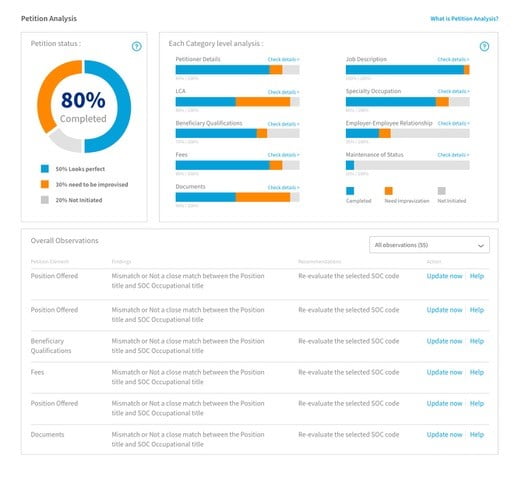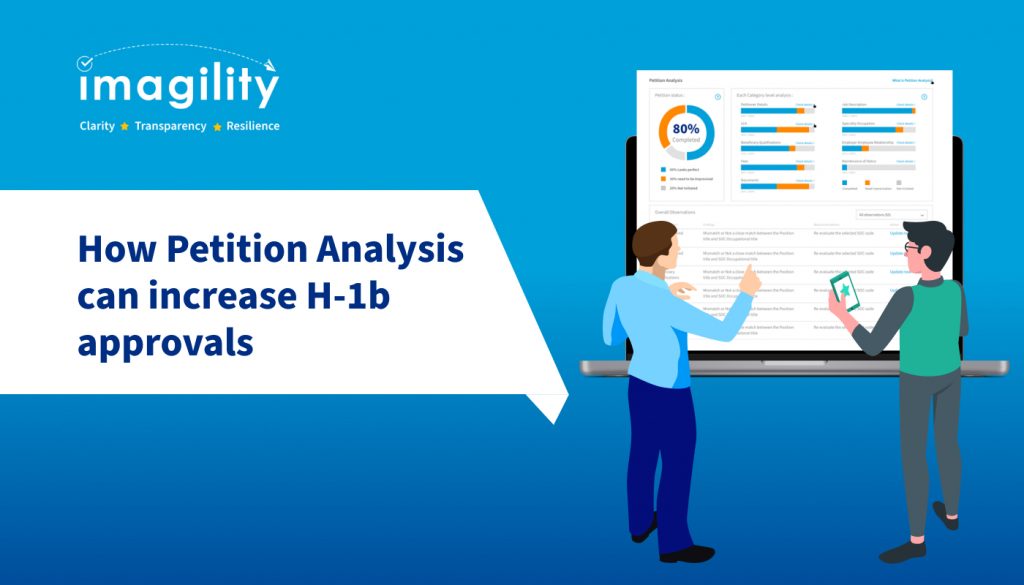Introduction
Immigration is shifting constantly, particularly in the last four years, given the changes in political and economic scenario over the last few decades. As a result of the BAHA executive order policy changes, building a petition has become complex and requires expert technical assistance to support the petitioner (or attorney) to build a petition. Given the innumerable variables in building a H-1B petition, without any flaws or gaps, we can leverage technology to check and analyse built petitions, to increase the chances of a favourable outcome by at least 40%. This document covers this premise of how Imagility’s petition analysis, powered by AI and ML, can improve the chances of H-1B approvals.
The H-1B Immigration Landscape
The H-1B immigration Landscape can be classified into pre 2016 and post 2016 timeframes. To understand the H-1B petition with all its elements, we need to understand the H-1B evolution timeline over the years. The H-1B today, is not what it used to be pre-2016. But first, lets get to know the H-1B program better.
The H-1B Program
H-1B visas allow immigrants with specialized knowledge/education, to temporarily work in the US in their specialized fields for American companies, for which the employer cannot find a US based worker. Some of the occupations include engineers, teachers, accountants, among others.
The H-1B visa is sponsored by the American company(employer) that has hired him/her, pays the visa fees and submits the required paperwork on behalf of the applicant. Validity of the visa is 3 years, can be extended upto six years. H-1B is one of the few visas where family members can join the visa holder for the visa time duration on H4 visas. The H-1B lottery is a hectic time for applicants to be selected either in the 65,000 regular pool or 20,000 masters’ cap. It is an equally hectic time for Petitioners and Attorneys to finish filing all petitions, along with the necessary paperwork.
The Changed Landscape
A lot changed in the Trump era – denials of new H-1B petitions for initial employment rose from 6 percent in FY 2015 to 21 percent in FY 2019, the denial rate for petitions for continuing employment stood at 12 percent in FY 2019 – up from just 3 percent in FY 2015. (source: americalimmigrationcouncil.org).Some patterns emerged during these years that would change the way petitions were getting built.
What got highlighted is the petition building process and the importance of building the key petition elements – Job description, LCA, specialty occupation, beneficiary qualification, employer-employee relationship – the right way, with the support letter, complete list of documents needed and the completeness of those documents, along with a thorough review and analysis, to make sure nothing is missing or off. Technical depth to build each of these key elements of the petition was the need of the hour.
Building Petitions Vs. Forms
It is a common misconception that the H-1B petition is all about filling out the i-129 form or any other appropriate form. Form filing is just one part of the process of petition building. Relevant information and details needed for the forms are gathered. But there are a lot of details apart from this that need to be furnished to improve the outcome of the petition.
Designing the Job Description
A detailed Job description explains how each activity is unique, specialized in nature and is related to the technology the individual is expected to work with, setting the tone for a specialized occupation. It is necessary to detail out all the duties and sub duties a person holding this position will need to perform. This is beyond what the form dictates, but much needed for the petition.
Selecting the Right LCA
For purposes of the specialized knowledge analysis, the LCA has a few key components – Job or position title, SOC code and wage level. The preparer has to pick the right LCA code wisely after mapping the wage level and educational qualification mostly picked for the position. There is a need to look up the position in the Occupational Outlook Handbook (OOH) to map these criteria and is not defined in the form.
Building a better case with Specialty Occupation
For the position to qualify for H1-B, the position has to be proven as a specialty occupation. This means that the position by itself is unique or complex or specialized and requires at least a bachelor’s degree to hold. Preparers need to select the right LCA and then make sure that the specialized duties of the position (elaborated in the Job description), map to the LCA list of duties. There is no pre-set formula for this and goes beyond form filling.
Justifying Beneficiary Qualification
There is a need to prove that the beneficiary is qualified for this specialty occupation. If the beneficiary has a related bachelor’s or masters’ degree, its straightforward. But sometimes, an individual’s education may not be in the exact field, but in a related field instead. For such individuals, their work experience and expertise along with any extra courses and certifications will justify their qualification for the position. In such cases, a detailed itinerary of services will justify the beneficiary’s qualification for the said position. This is in the realm beyond form filling and needs the preparer to diligently dig out relevant details of the beneficiary’s education and work experience and map it to the various job duties.
Employer Employee Relationship
There has to be a qualified employer who provides a specialty occupation, needing specialized skills of a qualified individual and maintains the right wage levels for remuneration. Building a case to prove the kind of employment that exists between employer and employees with the right documents and support letters is vital. Intelligent and informed decisions is what builds the right kind of case, not blind forms filling.
Reviewing, Analysing, and Improving Petitions
Imagility is a cloud-based end-to-end immigration platform, with powerful and intelligent petition building, petition analysis and RFE response building features.
It leads the user through a guided approach to building petitions. Petition Analysis carries out an elaborate process of checks through built petitions and makes intelligent recommendations through reports to improve petition success rates, giving you infinite chances to correct and improve the identified elements in the petition. Machine learning tools power the RFE Response Builder to construct accurate RFE responses quickly.
What is Petition Analysis?
Imagility’s Petition Analysis checks the various petition elements against the requirements from USCIS and generates a consolidated report at the end of the process. At the click of a button, the system starts the petition adjudication process. The system analyses various elements of the petition like all filing requirements, petitioner requirements, position details, presence of required documents, correct fees, etc. At the end of the process, users shall be able to view the report that visually represents the completeness of the petition, findings from the analysis and recommendations from Imagility.
How does it work?
Once all the sections of the petition are completed, analysis of the petition can be initiated simply by clicking the Adjudicate Petition button under the Review Petition timeline step.
Users can view the progress of the analysis through an interactive interface with options to navigate to next step, skip or see more information about elements under analysis. Once all elements are checked, the user can click the Finish button to view results.

This gives the petitioner an opportunity to revisit the relevant sections and correct required details based on the recommendations suggested by the system. This helps in making the petition stronger, before submitting it to the reviewer and subsequently to the USCIS thereby avoiding denials or RFEs.
Petition Analysis Categories
Imagility’s Petition Analysis carries out check /analysis of the petition created under the following categories executed as different steps when analyzing a petition:
Review filing requirements
In this category, Imagility checks for the correctness of different categories of the fees based on the type of petition, number of employees of the company. Also, filing date (current date) is validated against the position start date to avoid petition filing earlier than required.
Analyze the job description
In this category, petition analysis evaluates the position requirements to check whether it meets the requirement of specialty occupation. Petition analysis engine runs through the entered job duties of the petition, to check whether those describe and qualify as specialty skills, required to perform the job. Job duties are evaluated, and recommendations are given for improvement, if any.
Identify any missing documents
In this category, documents under Beneficiary education and experience documents, Beneficiary immigration documents, Beneficiary employment documents and Petitioner/Client documents are validated for availability based on the type and status of beneficiary.
Check for the correctness of the LCA
In this category, Imagility validates the LCA applicability to the petition position. In addition, LCA validity dates and work location are checked against petition employment dates and location.
Review position related requirements
In this category, Imagility evaluates the position requirement to check whether it meets the requirement of specialty occupation in terms of education, training required to perform the duties including the skills required for the position.
Review the beneficiary qualifications for the position
Here the qualifications of the beneficiary like degree, field of study, tools and technologies used, prior experience in performing similar duties are checked against the requirement of the position.
Check the employer-employee relationship
Availability of required documents that shows the beneficiary has an offer of employment with the petitioner are checked under this category. Also looked for document that has the proper reporting structure established within the organization and/or at client location, if applicable.
Check the eligibility of the beneficiary’s status
Beneficiary needs to ensure he/she is working in the US, by maintaining the required status. i.e., having valid status at the time of filing the petition and having job continuity during his/her stay without a gap of more than 60 days etc. Imagility evaluates along these criteria in this category.
Review petitioner requirements
In this category, Imagility validates petitioner information against reference databases, checks for any identifiers for fraud based on employee strength, company revenue, frequency of petition filing and the petitioner’s eligibility to file certain types of petition. Also, presence of signatures from Petitioner & Attorney in relevant forms is checked to ensure the petition completeness.
Thus, the petition analysis process makes the petition thorough, and fills all that gaps to make the petition complete, thereby increasing its success rate hugely.
Petition analysis saves time and improves success rates
Petition preparers can save themselves time because all core elements of the petition are thoroughly checked against USCIS requirements. After petition analysis is done, category analysis details and overall observations and recommendations are displayed on a graphical dashboard. Category analysis includes the percentage of completeness of each category like filing requirements, petitioner requirements, job description, specialty occupation, presence of required documents, correct fees, etc are displayed with distinct colors. This gives preparers a great chance to fix all missing details promptly without having to manually look for weak petition elements. Clicking the Check details link under each category takes the preparer directly to the related timeline step. Recommendations to fix missing details guides preparers to improves success rates of petitions. The best part is that this virtual adjudicator feature can be run multiple times, until you are satisfied.
In short, the powerful petition analysis feature is an invaluable tool for preparers to drastically cut down rejection rates of petitions, with very little effort and time.









